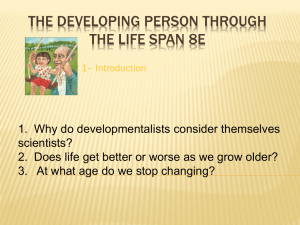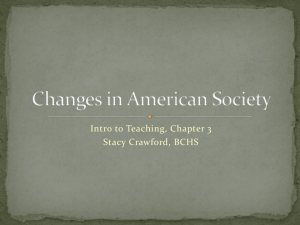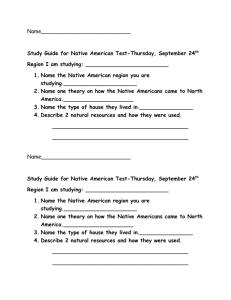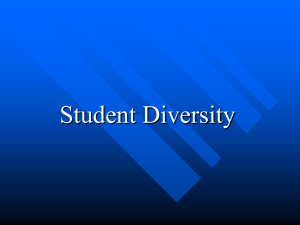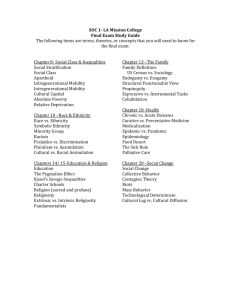chapter 1
advertisement
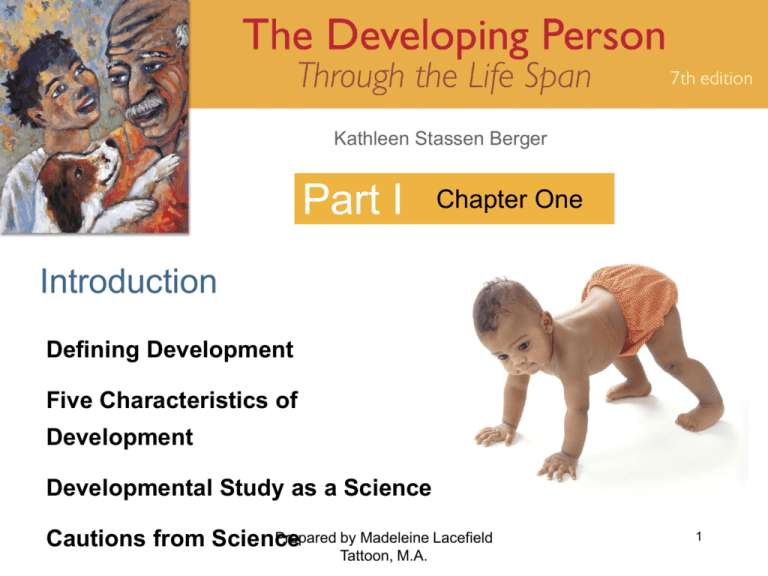
Kathleen Stassen Berger Part I Chapter One Introduction Defining Development Five Characteristics of Development Developmental Study as a Science Prepared by Madeleine Lacefield Cautions from Science Tattoon, M.A. 1 Beginnings 2 Introduction What will happen to the baby just born, or to the schoolchild trying to make a friend, or to the emerging adult wondering how to pay for college, or to the elder contemplating retirement? Why should you care? 3 Defining Development The science of human development seeks to understand how and why people—all kinds of people, everywhere—change or remain the same over time. There are 3 crucial elements. 4 1. Science • developmental study is a science…. – theories – data – analysis – critical thinking – sound methodology 5 2. Diversity • studying all kinds of people – young and old – rich and poor – every ethnicity, background – sexual orientation 6 3. Connections Between Change and Time • Changing or remaining the same over time – transformations – consistencies of human life • beginning to end – understanding each segment of life 7 Dynamic Systems Theory • stresses the fluctuations and transitions – the dynamic synthesis of multiple levels of analysis • the interaction between people and within each person – parent and child – prenatal and postnatal life – between ages 2 and 102 8 Bioecological Systems • Urie Bronfenbrenner – a leader in understanding ecological systems approach • he believed that developmentalists need to examine all systems surrounding the development of each person – microsysems – exosystems – macrosystems 9 The Ecological Model • microsysems – a person’s immediate surroundings • exosystems – local institutions, such as schools and churches • macrosystems – larger social setting, including cultural values, economic polices, and political processes 10 Five Characteristics of Development “…developmentalists are acutely aware of the reciprocal connections between one moment in life and another… leading to five principles that are useful for understanding any age of human life…” 11 1. Multidirectional • changes in direction; development is dynamic, not static – each fraction of a second – years are analyzed, revealing unexpected twist and turns 12 Gains and Losses 13 The Butterfly Effect – the power of a small change • all change may have a large effect • every change affects a dynamic system – a tiny event could have an enormous impact, not that is always does • opposite can occur… large changes can affect people in contradictory ways (i.e., lottery jackpots) 14 2. Multicontextual “…humans develop in dozens of contexts that profoundly affect their development…” – physical surroundings – family patterns • Social context – historical – socioeconomic 15 The Historical Context – corhort • people born within a few years of one another – these people are affected by the same » » » » values events technologies culture 16 The Socioeconomic Context – socioeconomic status (SES) • “social class” – – – – more than money occupation education place of residence • includes advantages and disadvantages • Question: does low SES cause damage in infancy or in late adulthood? 17 18 3. Multicultural “…culture affects each human at every moment… culture is so pervasive, people rarely notice their culture while they are immersed in it…” 19 Deciding What to Do Each Moment – culture • the patterns of behavior that are passed from one generation to the next • groups have their own culture – – – – – – values customs clothes dwellings cuisine assumptions • people are influenced by more than one culture 20 Ethnicity, Race, and Income – ethnic groups – share certain attributes » » » » » ancestral heritage national origin religion culture language • ethnic categories arise from history, sociology, and psychology, not from biology 21 Ethnicity, Race, and Income – race – used to categorize groups of people » based on appearance » 95% of the genetic differences between one person and another occur within, not between, supposed racial groups • race is misleading as a biological category – race = social construction – an idea created by society – perceived racial differences lead to discrimination – affect cognition 22 Ethnicity, Race, and Income – social construction • SES (socioeconomic status) – a form of income or wealth – overlaps with ethnicity and race – national history and SES affect culture, development 23 Issues and Applications “My Name Wasn’t Mary” 24 4. Multidisciplinary “…a broad array of disciplines and crosscutting topics… each person develops simultaneously in body, mind, and spirit…” Development is divided into three domains; – biosocial – cognitive – psychosocial 25 The Three Domains 26 Mirror Neurons – reflected brain cells – observed actions • mirror the intentions, sensations, and emotions of those around – implications of Mirror-Neuron Research • possible cultural transmission or social organization 27 5. Plasticity • denotes two complementary aspects of development – human traits can be molded • yet maintaining durability of identity • culture and upbringing affect both aspects of plasticity • Genes and other biological influences – provides hope and realism • hope = changes is possible • realism = each developing person must build on what has come before 28 Developmental Study as a Science • • based on objective evidence laden with subjective perceptions • making developmental science challenging 29 Steps of the Science Method • to avoid distortions of unexamined opinions and to control the biases of personal experience 1. 2. 3. 4. 5. – ask a question developing a hypothesis test the hypothesis draw conclusions Make the finding available Replication 30 Ways to Test Hypotheses • Four methods: 1. 2. 3. 4. Observation The Experiment The Survey The Case Study 31 Observation • record behavior systematically and objectively – occur in a naturalistic setting – tries to be unobtrusive – can occur in a laboratory or in searches of archival data 32 The Experiment • used to establish cause – a particular treatment to expose to a specific condition • notes whether their behavior changes – – independent variable = imposed treatment or special condition dependent variable = specific behavior being studied » » experimental group: is given a particular treatment control group: does not get the treatment 33 The Experiment 34 The Survey • Information is collected from a large number of people by: – interview – questionnaire – some other means • wording and the questions can influence answers 35 The Case Study • intensive study of one individual or situation – asking about past history – current thinking – future plans • can provide unanticipated insight 36 Studying Change over Time 37 Studying Change over Time • Cross-Sectional Research – designed to compare groups of people who differ in age but share other important characteristics (i.e., education, SES, ethnicity) 38 Studying Change over Time • Longitudinal Research – design in which the same individuals are followed over time and their development is repeatedly assessed 39 Studying Change over Time • Cross-Sequential Research – designed to first study several groups of different ages and then follow those groups over the years 40 Caution from Science • developmental scientists also discover changes that are not beneficial – television, divorce, shift work, automobiles. 41 Caution from Science • Correlation and Causation – can be confusing • a correlation indicates the degree of relationship between two variables. – – – a correlation is positive if both variables tend to increase or decrease together a correlation is negative if one variables tends to increase when the other decreases a correlation is zero if no connection is evident 42 Caution from Science • Quantity and Quality – a second caution concerns how much scientists should rely on data produced • • quantitative research: provides data that can be expressed with numbers qualitative research contains descriptions of conditions, and participants’ ideas 43 Caution from Science • Ethics in Research – Caution for all scientists is to ensure that research meets ethical standards • “code of ethics” – A set of moral principles that members of a profession or group are expected to follow 44 Caution from Science • Protection of Research Participants – Researcher must ensure that participation is voluntary, confidential, and harmless 45 Caution from Science • What should we Study? – Consider the most important ethical concern: • “Are scientists studying issues that are crucial to human development?” 46
